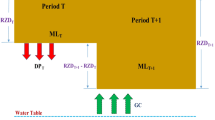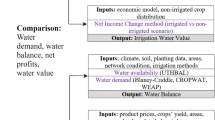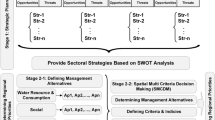Abstract
An increase in demand, and droughts in recent years have resulted in the need for tools to allocate limited water between users in different regions in order to achieve economic, social and environmental benefits. Multi-objective planning is an important decision support tool for natural resource management. Planners, decision makers and stakeholders use this approach in the decision-making process. In this research, a multi-objective planning model was developed and applied on the Menemen Left Bank Irrigation System of the Lower Gediz Basin in Turkey. The aims of the model were to increase the benefit from production, to increase the size of the total area irrigated, and to reduce the water losses occurring at network level. The model was applied to an open channel system consisting of 44 tertiary channels receiving water from three secondaries, serving an area of 3,606 ha. The model predicted a 20.63% increase in income, and a 29.26% decrease in the total irrigation water requirements of crops dependent on projected changes in the actual crop pattern of the research area. This decrease caused a reduction of 29.90% in expected water losses over the network as a whole. The operation of the model enabled optimum productivity and income at the system level per unit of land and water resources.
Similar content being viewed by others
References
Agha SR (2006) Use of goal programming and integer programming for water quality management-a case study of Gaza Strip. Eur J Oper Res 174(3):1991–1998
Al-Zahrani MA, Ahmad AM (2004) Stochastic goal programming model for optimal blending of desalinated water with groundwater. Water Resour Manag 18(4):339–352. doi:10.1023/B:WARM.0000048487.05662.88
Babel MS, Das Gupta A, Nayak DK (2005) A model for optimal allocation of water to competing demands. Water Resour Manag 19:693–712. doi:10.1007/s11269-005-3282-4
Baran T, Durnabaş I, Öziş U, Gül S (1999) Surface water potential of Ege Region. Izmir Water Congress, Izmir, pp 57–73, (in Turkish)
Booker JF, O’Neill JC (2006) Can reservoir storage be uneconomically large? J Water Resour Plan Manage - ASCE 132(6):520–523
Chambers R (1988) Managing canal irrigation: practical analysis from South Asia. Cambridge University Press, Cambridge
Chang NB, Wen CG, Wu SL (1995) Optimal management of environmental and land resources in a reservoir watershed by multiobjective programming. J Environ Manag 44(2):145–161. doi:10.1006/jema.1995.0036
Crawley PD, Dandy GC (1993) Optimal operation of multiple-reservoir system. J Water Resour Plan Manage 119(1):1–17. doi:10.1061/(ASCE)0733-9496(1993)119:1(1)
Devi S, Srivastava DK, Mohan C (2005) Optimal water allocation for the trans-boundary Subernarekha River, India. J Water Resour Plan Manage 131(4):253–269. doi:10.1061/(ASCE)0733-9496(2005)131:4(253)
Doorenbos J, Kassam AH (1979) Yield response to water. FAO, Rome, Irrigation and Drainage Paper 33
DSI (1998) Menemen left bank irrigation system project reports. Menemen İşletme ve Bakım Başmühendisliği, DSI 21. Şb Müd Izmir-Turkey (In Turkish)
DSI (2006) Menemen left bank irrigation system operation reports. DSI 21. Şb Müd Izmir-Turkey (In Turkish)
Elnaboulsi JC (2001) Nonlinear pricing and capacity planning for water and wastewater services. Water Resour Manag 15:55–69
FAO (1992) CROPWAT, a computer program for irrigation planning and management. Food and Agriculture Organization, Rome, Irrigation and Drainage Paper 46
Gastelum JR, Valdes JB, Stewart S (2009) A decision support system to improve water resources management in the Conchos Basin. Water Resour Manag 23:1519–1548. doi:10.1007/s11269-008-9339-4
Girgin A, Geçgel G, Gül S (1999) Evaluation of irrigation applications from the point of view of water management in the Gediz Basin. Izmir Water Congress, Izmir, pp 317–334 (In Turkish with English abstract)
Gorantiwar SD, Smout IK, Vairavamoorthy K (2006) Performance-based optimization of land and water resources within irrigation schemes. I: Method. Irrig and Drain Eng 132:332–340
Hussain I, Turral H, Molden D, Din Ahmad UM (2007) Measuring and enhancing the value of agricultural water in irrigated river basins. Irrig Sci 25:263–282
Khare D, Ediwahyunan Jat MK (2006) Assessment of conjunctive use of planning options: a case study of Sapon irrigation command area of Indonesia. J Hydrol ASCE 328:764–777
Kilic M (1997) Evaluation of irrigation potential of the research, application and production farm of the Ege University. MSc Thesis, Fen Bil Enst, Bornova, Izmir, Turkiye (In Turkish with English abstract)
Kilic M (2004) Determining the optimum water allocation in irrigation networks by nonlinear programming method. PhD Thesis, Fen Bil Enst, Bornova, Izmir, Turkiye (In Turkish with English abstract)
Kilic M (2006) Optimizing the simultaneous allocation of alternative water resources varying in temporal and spatial dimensions to a tertiary rotation group. International symp on water and land management for sustainable irrigated agriculture, 4–8 April, Adana / Turkey
Kilic M (2007) Interactive planning of canal rotation system in real-time condition for Lower Gediz Basin Irrigation Network: method and application. Proc. of the international congress on river basin management, Antalya- Turkey, 626–639
Kilic M (2008) ‘Interrand 3.1’ a computer program for determining the water conveyance loss (and efficiency) in open channel irrigation systems (with Turkish interface). (published in Ege University Scientific Research Project: 2006-ZRF-047)
Kilic M, Ozgurel M (2005) Resource leveling and optimization of irrigation in a tertiary canal irrigation unit. Ege Univ J Agric Fac, Bornova / İzmir- Turkey 42(2):97–108 (In Turkish with English abstract)
Kilic M, Tuylu GI (2008) Determining the water conveyance efficiency for Ahmetli Regulator Irrigation System in Lower Gediz Basin. Ege University Scientific Research Project. Project Number: 2006-ZRF-047, Izmir, Turkey 53 p. (In Turkish with English abstract).
Kodal S (1996) Irrigation scheduling, from optimization and optimum water distribution with adequate and limited water supply in Ankara-Beypazarı Ecology. Ankara Univ. Faculty of Agriculture Dept. of Irrigation and Agricultural Structures. Number: 1465, Scientific Researches: 807 (In Turkish with English abstract)
Kodal S, Aküzüm T, Çakmak B, Kendirli B (1997) Irrigation schedules with adequate and limited water of some field crops grown in Urfa Region. VI. National Kültürteknik Congress, 5–8 June, Kirazlıyayla- Bursa, 354–362 p (In Turkish with English abstract)
Laborte AG, Van Ittersum MK, Van den Berg MM (2007) Multi-scale analysis of agricultural development: a modeling approach for Ilocos Norte, Philippines. Agric Sys 94:862–873
Lawrence JA, Pastemack BA (1998) CD-ROM for applied management science a computer integrated approach for decision making. Wiley and Sons Inc
Liu X, Chen X, Wang S (2009a) Evaluating and predicting shadow prices of water resources in China and its nine major river basins. Water Resour Manag 23:1467–1478. doi:10.1007/s11269-008-9336-7
Liu Y, Yu Y, Guo H, Yang P (2009b) Optimal land-use management for surface source water protection under uncertainty: a case study of Songhuaba Watershed (Southwestern China). Water Resour Manage 23:2069–2083. doi:10.1007/s11269-008-9370-5
Lund JR (2006) Drought storage allocation rules for surface reservoir systems. J Water Resour Plan Manage—ASCE 132(5):395–397
Mannochi F, Mecarelli P (1994) Optimization analysis of deficit irrigation systems. Irrig Drain Eng 120(1):484–503
MLBIA (Menemen Left Bank Irrigation Association) (2006) Reports. MLBIA, Menemen (In Turkish)
Molden D, Sakthivadivel R, Zaigham H (2001a) Basin-level use and productivity of water: examples from South Asia. Research Report no.49. Int Water Management Institute, Colombo
Molden D, Upali A, Intizar H (2001b) Water for rural development: background paper on water for rural development prepared for the World Bank. IWMI Working Paper 32. Int Water Management Institute, Colombo
Montazar A, Riazi H, Behbahani SM (2009) Conjunctive water use planning in an irrigation command area. Water Resour Manag 24:577–596. doi:10.1007/s11269-009-9460-z
Nayak RC, Panda RK (2001) Integrated management of a canal command in a river delta using multi-objective techniques. Water Resour Manag 15:383–401
Reddy JM, Kumar ND (2008) Evolving strategies for crop planning and operation of irrigation reservoir system using multi-objective differential evolution. Irrig Sci 26:177–190
Sagardoy JA, Bottrall A, Uittenbogaard GO (1982) Organization, operation and maintenance of irrigation schemes. FAO Irrig Drain Pap 40:166
Svendsen M, Murray-Rust DH, Harmancioglu N, Alpaslan N (2001) Governing closing basins: the case of the Gediz River in Turkey. In: Abernethy CL (ed) Intersectoral management of river basins. International Water Management Institute, Colombo
Topraksu (1971) Soil researches for Menemen District. Topraksu Gen. Müd., Toprak Etüd ve Haritalama Dairesi, Yay. No: 236, Ankara (In Turkish)
Topraksu (1974) Gediz Basin Soils. Topraksu Gen. Müd., Yay. No: 302, Ankara (In Turkish)
Verma MK, Shrivastava RK, Tripathi RK (2010) Evaluation of min–max, weighted and preemptive goal programming techniques with reference to Mahanadi Reservoir Project Complex. Water Resour Manag 24:299–319. doi:10.1007/s11269-009-9447-9
Author information
Authors and Affiliations
Corresponding author
Rights and permissions
About this article
Cite this article
Kilic, M., Anac, S. Multi-Objective Planning Model for Large Scale Irrigation Systems: Method and Application. Water Resour Manage 24, 3173–3194 (2010). https://doi.org/10.1007/s11269-010-9601-4
Received:
Accepted:
Published:
Issue Date:
DOI: https://doi.org/10.1007/s11269-010-9601-4




